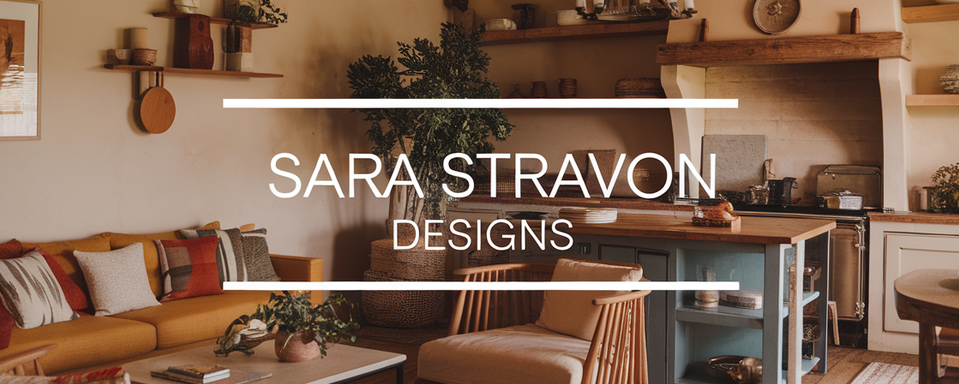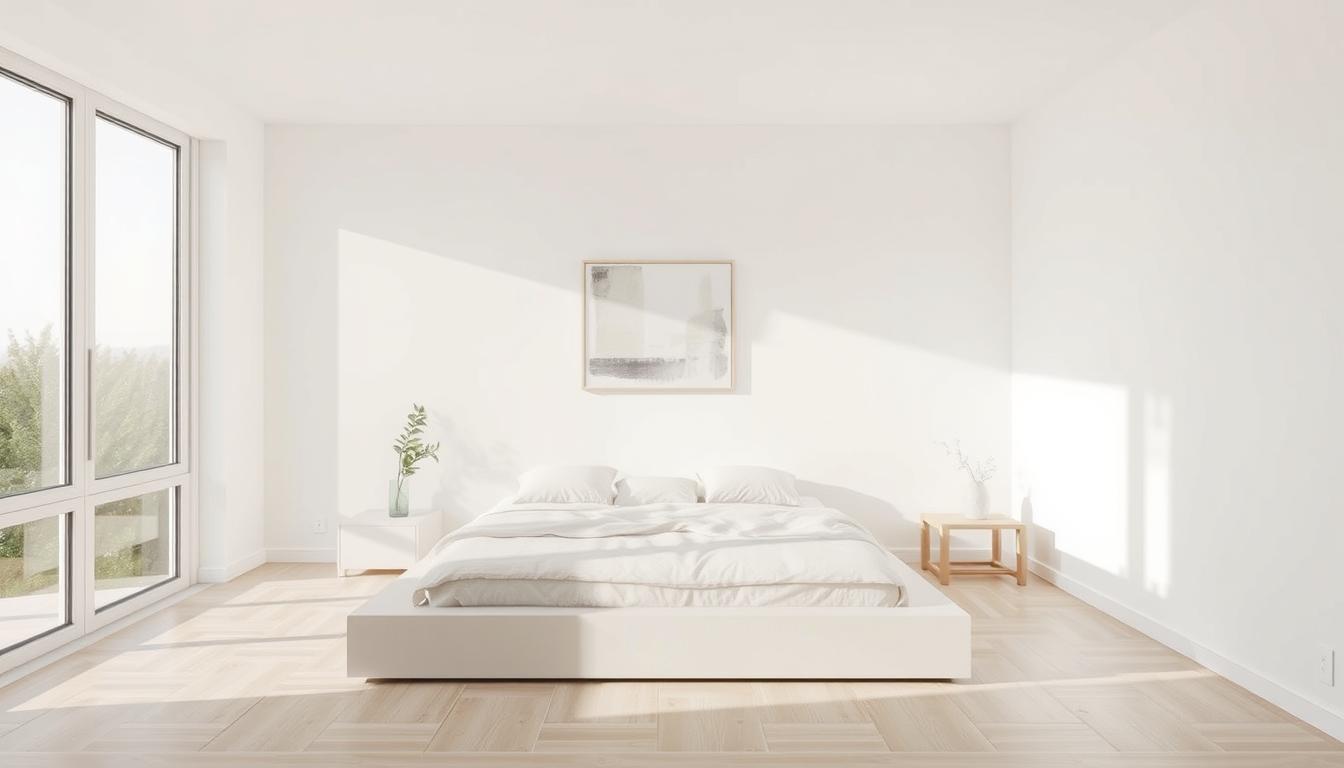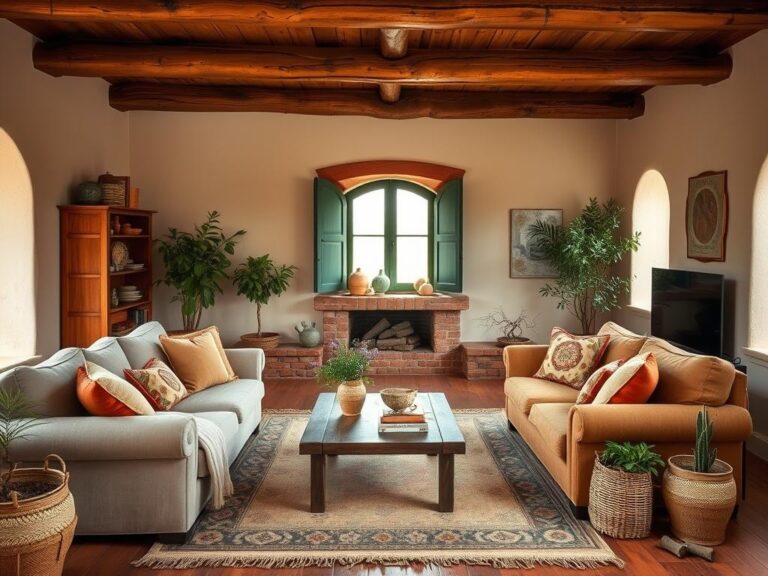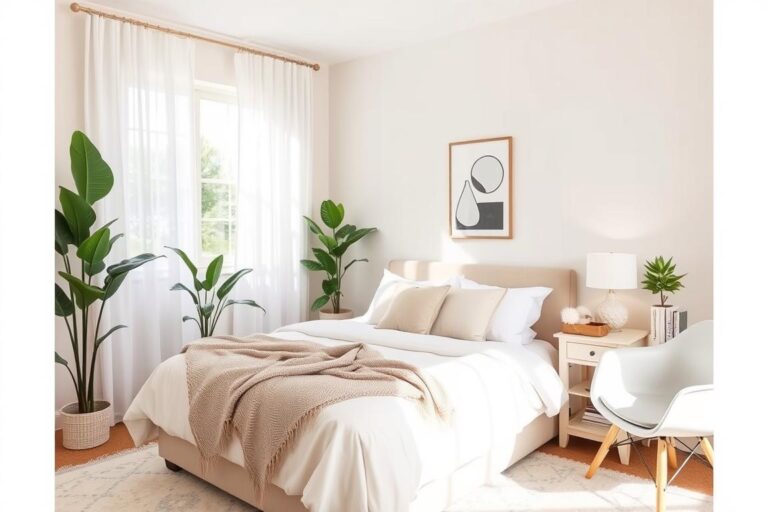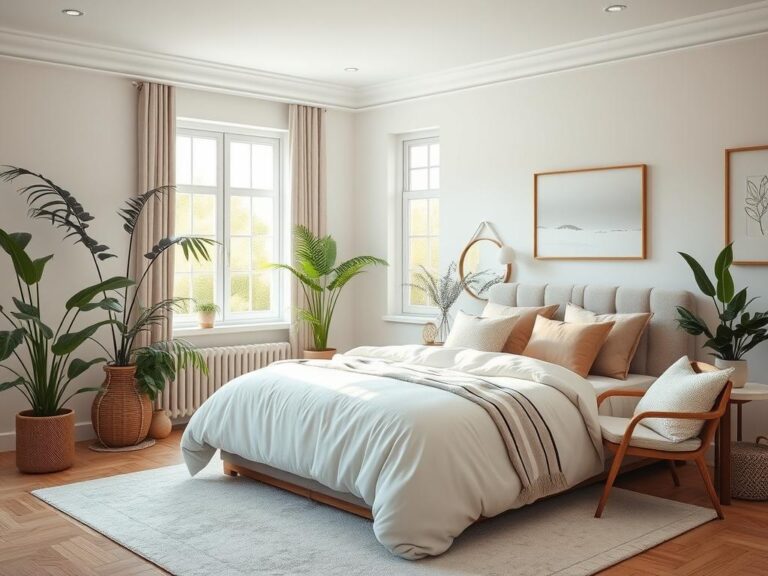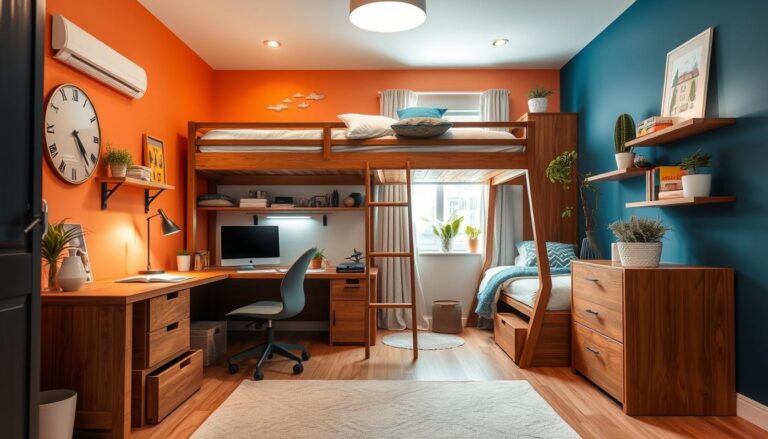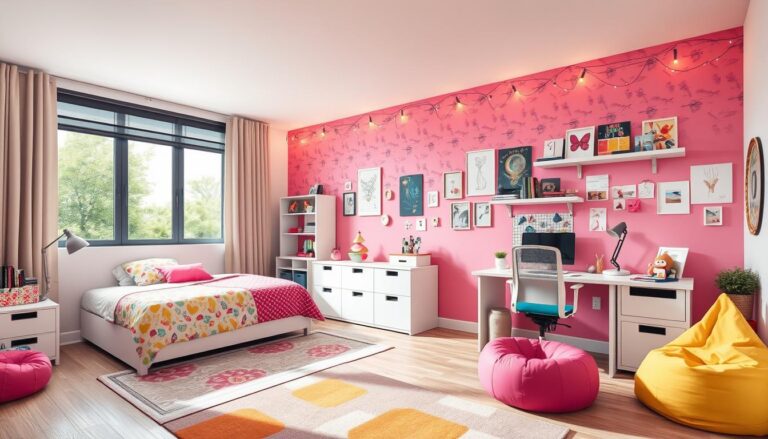Have you ever noticed how some people’s homes feel calm, while others seem chaotic? In today’s fast world, we all need a peaceful spot at home. A minimalist bedroom is more than a trend; it’s a way to mix simplicity with calm.
By choosing calming colors and useful furniture, you can make a cozy retreat. Minimalist bedroom ideas help us find peace by removing clutter. As a busy mom, I’ve learned to love simplicity. I’m excited to share these ideas with you!
Important points
- Neutral colors like white and beige create an inviting atmosphere.
- Floating nightstands and streamlined dressers maximize storage.
- Natural light enhances tranquility within the space.
- Incorporating greenery can add life and balance to your bedroom.
- Quality bedding layered with textures promotes comfort and luxury.
Minimalism in Bedroom Design
Minimalism is all about simplicity and function. It’s not just about empty spaces. It’s about removing what’s not needed and keeping only the essentials. This approach helps create a calm and peaceful space.
By focusing on meaningful items, our bedrooms become a quiet escape from the world outside. It’s a place where we can relax and unwind.
What is Minimalism? It is Amazing How Many People Don’t Know.
Minimalist bedroom design is all about clean lines and no clutter. It makes our space calm and inviting. This style started in the 1960s, inspired by art.
Today, it’s more than just design. It’s a way of life that simplifies our surroundings and our thoughts. Neutrals like whites and grays are key, making the space feel open and airy.
What are The Benefits of a Minimalist Bedroom
Choosing simplicity in bedroom design brings many benefits:
- It creates a calm space that helps us sleep better.
- It reduces stress by keeping things tidy.
- It promotes organization with smart storage.
- It encourages us to choose our furniture and decor carefully.
Minimalist bedrooms are calming and balanced. They have simple, elegant furniture and a limited color palette. This makes the space visually appealing without feeling too much.
Adding plants brings warmth and life, making the space cozy yet sophisticated. It’s a perfect blend of calm and style.
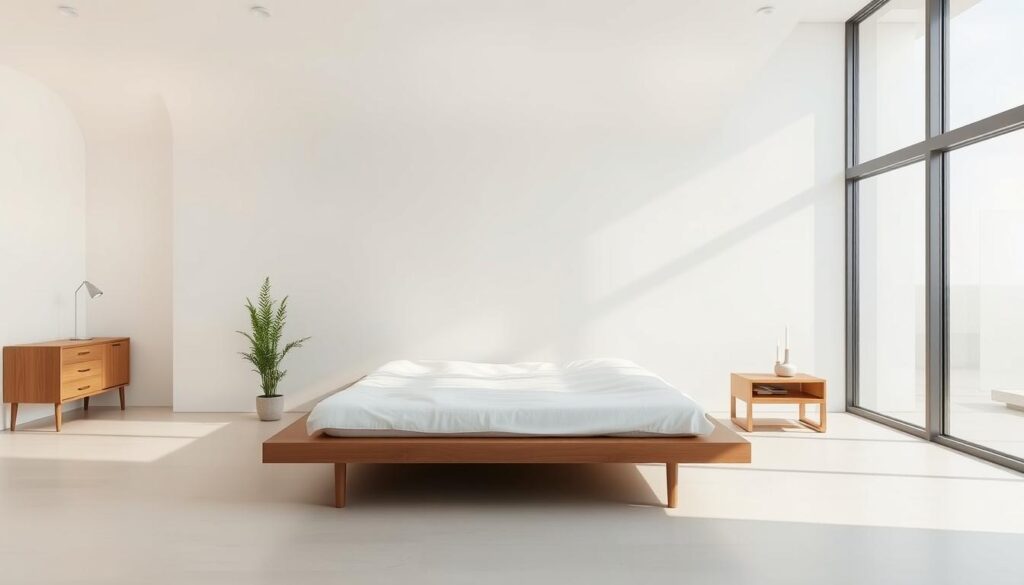
| Aspect | Description |
|---|---|
| Color Scheme | Predominantly neutral tones such as white, beige, and soft gray. |
| Furniture Design | Modern, understated styles that promote openness and tranquility. |
| Décor Elements | Minimal, carefully selected items like a single artwork or plant. |
| Spatial Planning | Appropriately sized furniture avoiding overcrowding to maintain flow. |
Essential Elements of a Minimalist Bedroom
Creating a minimalist bedroom focuses on a few key elements. These elements work together to make a peaceful space. Colors, materials, and furniture are crucial for a calm atmosphere.
Color Schemes for Serenity
Neutral colors like whites, grays, and soft earth tones are essential. They make the room feel open and calm. Adding a bit of brighter color can add life without being too much.
Monochromatic schemes are also great. They add depth and character with different textures. Earth tones bring a sense of grounding and connection to nature.
Choosing the Right Materials
Natural materials are important for a minimalist look. Wood, bamboo, and stone add warmth and texture. High-quality textiles like linen and wool make the space cozy and inviting.
Functional Furniture Pieces
Every piece of furniture should have a purpose. Choose furniture that fits well and looks good. Streamlined designs like platform beds and floating nightstands are great.
Multi-functional pieces, like storage ottomans, are useful and stylish. Simple decor adds character without clutter. This creates a peaceful space that feels like a true sanctuary.
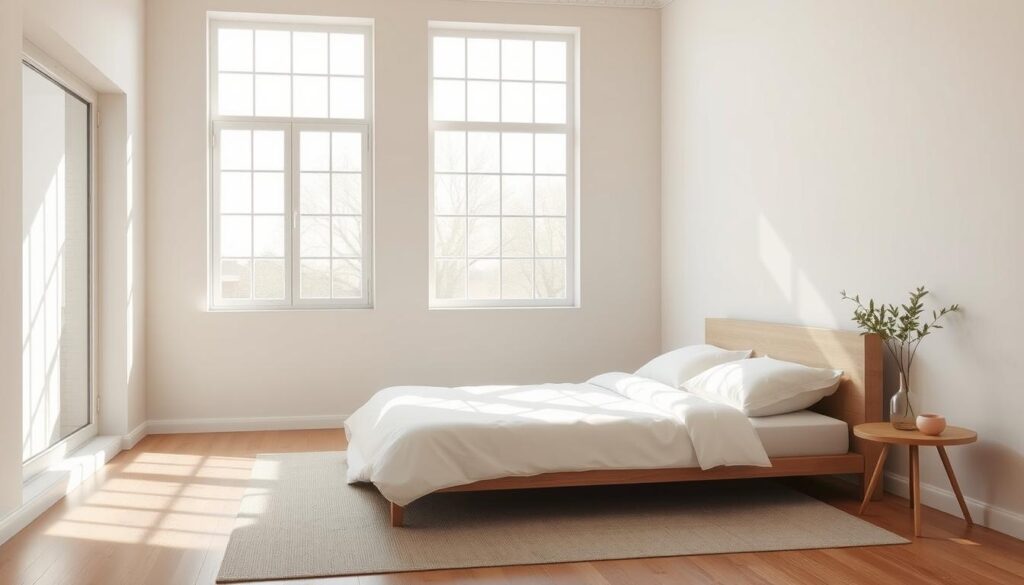
| Element | Description |
|---|---|
| Color Scheme | Use neutral colors like whites, grays, and earth tones to create a calming backdrop. |
| Materials | Incorporate natural textures such as wood, stone, and high-quality textiles for warmth. |
| Furniture | Choose functional and streamlined pieces that blend style with purpose. |
| Lighting | Implement soft lighting through pendant lights or mirrors to enhance tranquility. |
Declutter: The First Step to Minimalism
Starting my minimalist bedroom journey, I found decluttering is more than a task. It’s a change that brings peace. Begin by deciding what stays and what goes. Only keep items that make you happy or are useful.
Living without clutter makes your room look better and feels calmer. It improves your life too.
Tips for a Successful Declutter
Good decluttering means choosing wisely what to keep, give away, or throw away. Here are tips that helped me:
- Move things like papers, books, or old gadgets out of your bedroom.
- Make sure your bedroom floor is clear, with only the furniture you need.
- Keep dressers and nightstands tidy. Avoid cluttering them with too many items.
- Sort out your closet and drawers to use space better. You might not need all that furniture.
- Choose decorations that tell your story, not generic ones.
- Remove furniture that makes your room feel cramped. This improves the flow and your mind.
Storage Solutions that Work
Good storage is key for a minimalist bedroom. Here are some effective ways:
- Use under-the-bed storage for things like books or keepsakes. It keeps them hidden but easy to find.
- Choose accessories that are both simple and useful.
- A single color scheme makes your room feel bigger and keeps storage looking stylish.

Selecting Furnishings for a Minimalist Bedroom
Choosing the right furniture for a minimalist bedroom is key. It’s all about quality over quantity. Well-made pieces add beauty and are good for the planet. Each item should be both functional and elegant, making your bedroom a peaceful space.
The Importance of Quality over Quantity
In a minimalist room, every piece must have a purpose. High-quality furniture lasts longer, so you don’t need to replace it often. Durable materials keep your room looking great and working well. A solid bed frame or a classic dresser adds comfort and simplifies your life.
Multi-functional Furniture Options
Multi-functional furniture is a game-changer for small spaces. Look for items like:
- Storage ottomans that offer seating and hidden storage
- Convertible beds that can serve as a couch or guest bed
- Sleek nightstands with drawers for additional storage
- Fold-out desks that can be tucked away when not in use
These versatile pieces boost functionality and keep your room feeling spacious. Thoughtful choices ensure your minimalist space stays tidy and useful.
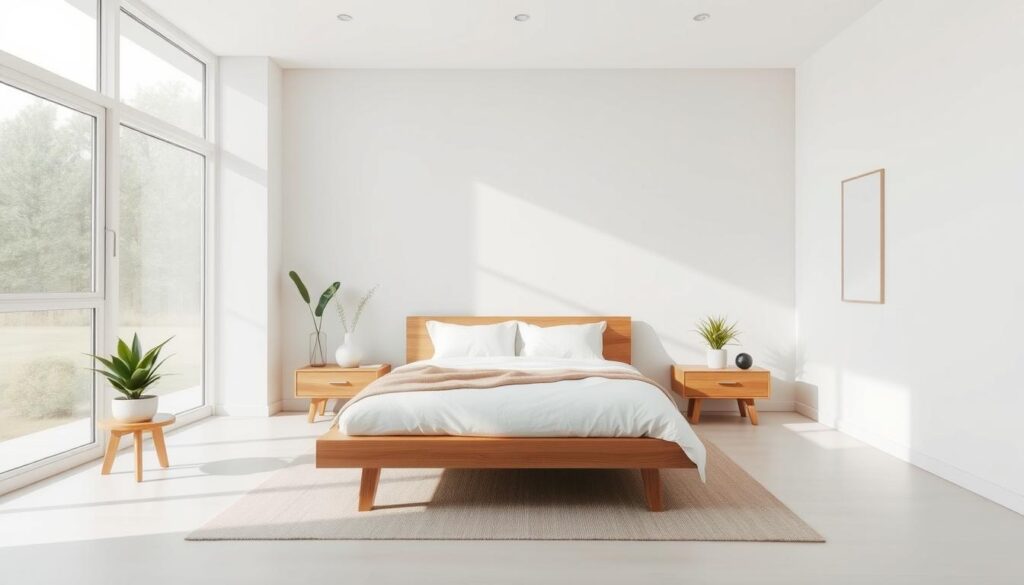
Natural Light: Enhancing Serenity
Natural light is key to a calming bedroom. It makes your space feel welcoming and cozy. Mirrors can make your room look bigger by reflecting sunlight.
Choosing the right window treatments is also important. Sheer curtains or elegant blinds add to the calm, minimalist look.
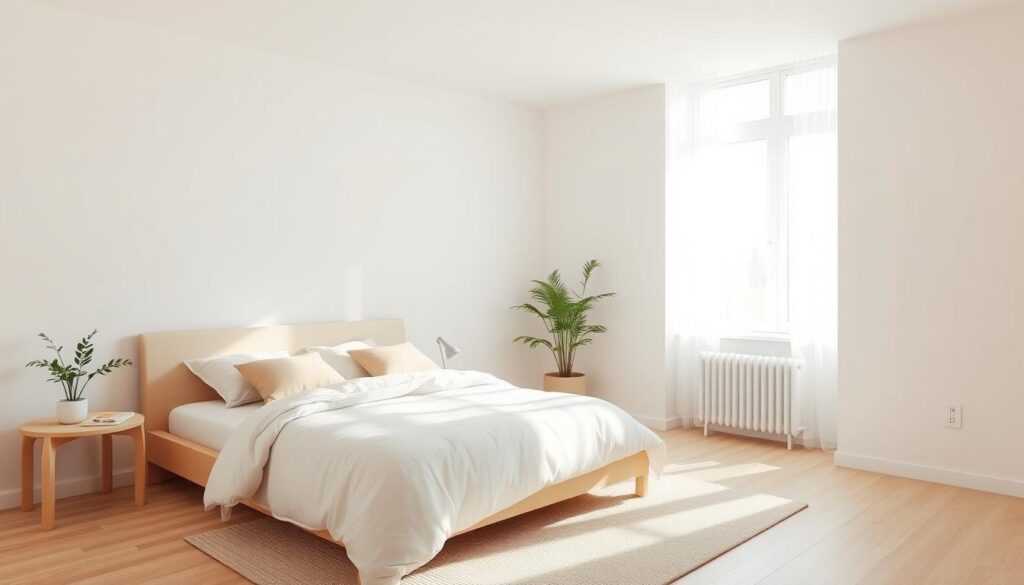
Maximizing Natural Light Sources
To make the most of natural light, try these tips:
- Use sheer curtains for soft, filtered light.
- Install big windows or skylights for more light.
- Place mirrors opposite windows to spread light around.
The Role of Window Treatments
Window treatments should be simple and stylish. Here’s how to pick the best ones:
- Look for treatments that are both functional and stylish.
- Avoid heavy drapes that block light.
- Choose light colors that match your decor.
| Window Treatment | Benefits | Considerations |
|---|---|---|
| Sheer Curtains | Softens light while allowing privacy. | May not block out much heat or glare. |
| Roller Shades | Simple and modern style with varying opacity. | Check if insulation is needed for energy efficiency. |
| Blinds | Controls light and privacy effectively. | Keep clean for optimal appearance. |
Creating a Calming Atmosphere
Designing a bedroom with calming minimalist aesthetics is all about the right textiles and natural elements. Soft fabrics like organic cotton and linen make the room feel serene and comfortable. It’s not just about looks; it’s about the feel too!
Choosing Soothing Textiles
Soft fabrics like organic cotton and linen create a peaceful space. They feel luxurious and look calming. Neutral colors like beige or soft gray add to the calm, fitting perfectly with your serene bedroom dreams.
I like mixing textures to add depth without clutter. A soft cotton duvet with a light throw creates a cozy feel while staying minimalist.
Incorporating Nature in Design
Adding nature to your bedroom brings peace and connection. Plants, natural wood, and earthy decor fit well with minimalist design. Plants like snake plants or peace lilies clean the air and add life.
Natural wood adds warmth and grounds the room. Keeping your space clutter-free lets it breathe and feel calming.
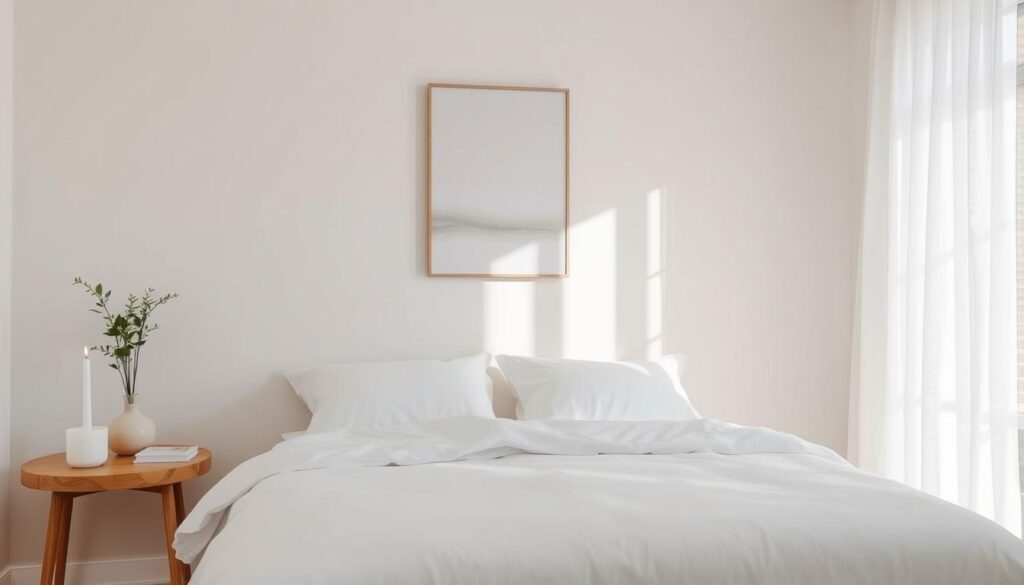
| Textile Type | Texture | Style Compatibility |
|---|---|---|
| Organic Cotton | Soft and breathable | Minimalist & Modern |
| Linen | Textured yet smooth | Scandinavian & Casual |
| Wool | Warm and durable | Cozy & Rustic |
| Silk | Luxurious and sleek | Elegant & Sophisticated |
To create a calming bedroom, mix soft textiles with natural elements. This thoughtful mix beautifies your space and brings tranquility. It invites relaxation and restful nights.
The Role of Art in Minimalist Bedrooms
Art is key in creating the mood of a minimalist bedroom. Choosing simple yet meaningful art adds to the calm vibe, fitting the minimalist style. A single, powerful artwork can stir emotions more than many pieces on a wall. It makes points of interest without feeling too much.
Selecting Simple, Meaningful Art
In minimalist decor, art should be simple yet full of meaning. Here are tips for picking the right art:
- Choose pieces that speak to you personally—they add a special touch to your room.
- Go for neutral colors or soft shades that match your room’s colors.
- Think about the size of the art; big pieces anchor, while small ones add to the decor.
Placement Tips for Maximum Impact
Where you place your art is key to making it stand out and keep the room calm. Here are some tips:
- Hang art at eye level for a natural focus point.
- Group small artworks together for a unified look, or have one big piece stand out.
- Think about the lighting—it can make your art look better and set the mood.
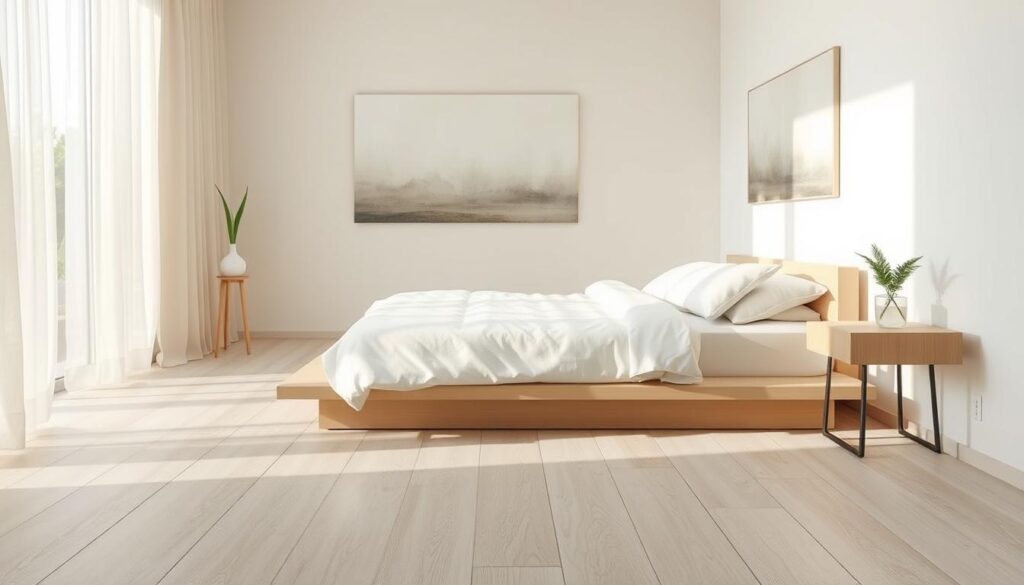
Adding art to your minimalist space shows your style and makes it more calming. With careful choice and placement, art can turn your bedroom into a peaceful retreat.
Color Psychology in Minimalist Design
Color psychology can change our bedrooms into peaceful places. In minimalist bedroom ideas, the right colors are key. They help create a calm atmosphere.
When picking colors, I think about how they make me feel. Neutral shades like white, beige, and gray are great. They let light in and make the room feel airy.
Colors that Promote Calmness
Soft, muted colors are essential for a calm look. Colors like pale blue, lavender, and warm beige make the room look good and help us sleep well.
I also choose natural tones like sage green and terracotta. They add life to the room without making it too busy. These colors make me feel connected to nature.
How to Use Accent Colors
Using accent colors wisely is important. Pale pastels like blush pink or mint green add a nice pop of color. I like using different shades of one color to add depth.
This keeps the room calm but interesting. Good lighting makes these colors stand out, making our bedrooms welcoming.

Balancing Functionality and Aesthetics
It’s key to find a balance between function and looks in a minimalist bedroom. Every little thing should help you relax and feel comfortable. I aim to make a space that’s welcoming and organized, just how I like it.
Creating a Space for Relaxation
Begin with a calm color scheme. Shades like beige and light gray make the room peaceful. Neutral colors also help keep the space tidy and organized.
Using furniture that does more than one thing, like ottomans, keeps the room open. This way, everything has a purpose.
Ergonomics in Bedroom Design
Good ergonomics is vital in bedroom design. Mattresses should support a good night’s sleep. Furniture should be easy to move around.
Opt for sleek shelves for storage that looks good. Adding quality textiles makes the room feel fancy but still simple. Think about how each piece, like a headboard or light, helps you relax.
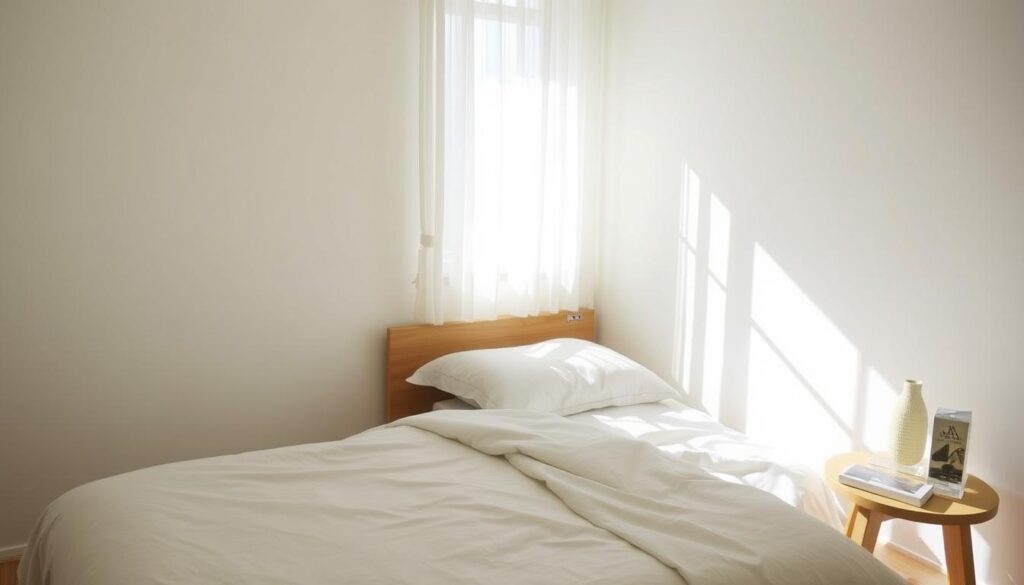
| Design Element | Description |
|---|---|
| Color Scheme | Predominantly neutral tones like white, beige, and soft gray, with occasional bursts of bright accents. |
| Furniture | Modern and understated designs that promote openness and tranquility, emphasizing clean lines. |
| Lighting | Concentrated lighting options such as pendant lights or wall sconces to enhance the calming ambiance. |
| Textiles | High-quality bed linens and textiles to create a luxurious yet uncluttered look for restful sleep. |
| Storage Solutions | Sleek shelving units and multi-purpose furniture, integrated thoughtfully for a practical minimalist approach. |
| Art and Decor | Curated pieces that tell a cohesive story, enhancing both functionality and aesthetic harmony. |
For more tips on mixing function and beauty in your bedroom, check out this page.
Maintaining Your Minimalist Bedroom
Keeping your minimalist bedroom calm and tidy is key. It’s not just about deep cleaning now and then. A regular cleaning routine helps keep things organized.
By regularly checking what you have, you can stop clutter from coming back. This lets your space stay peaceful and open.
Regular Maintenance Tips
Small daily habits can make a big difference. Spend a minute each day tidying up and putting things away. This keeps your bedroom calm and organized.
Also, getting built-in storage helps a lot. It keeps clutter down and makes your peaceful space even better.
Seasonal Decluttering Practices
Seasonal changes are a great time to refresh your space. Decluttering in spring or organizing holiday decorations in winter keeps your bedroom tidy. It also helps you feel more connected to your space.
By following these tips, you can enjoy a peaceful bedroom every day. Every little bit helps!
